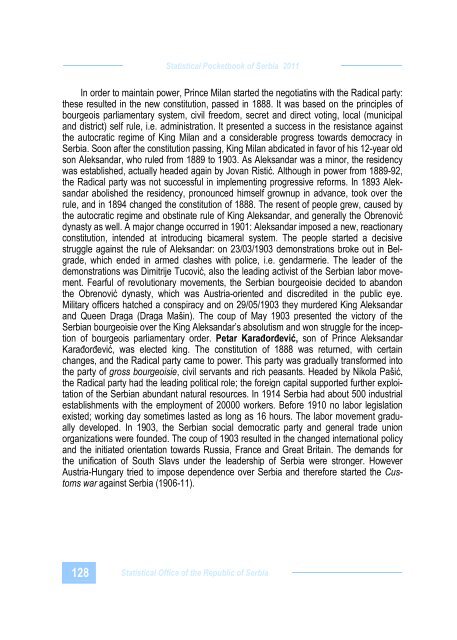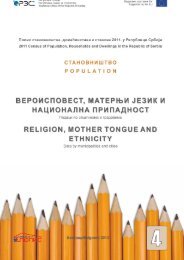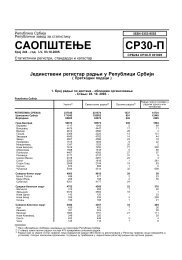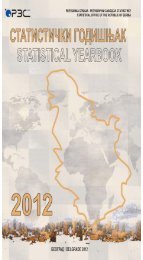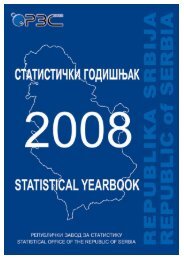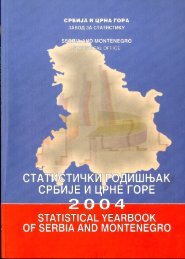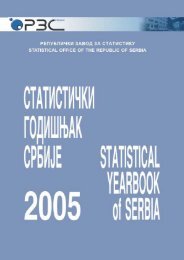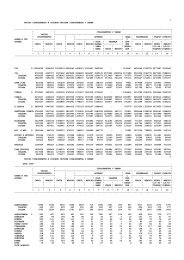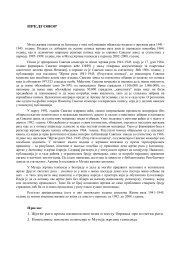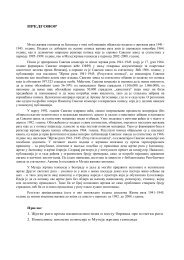ISSN 1820-6794
Full page fax print - Републички завод за статистику
Full page fax print - Републички завод за статистику
- No tags were found...
You also want an ePaper? Increase the reach of your titles
YUMPU automatically turns print PDFs into web optimized ePapers that Google loves.
Statistical Pocketbook of Serbia 2011In order to maintain power, Prince Milan started the negotiatins with the Radical party:these resulted in the new constitution, passed in 1888. It was based on the principles ofbourgeois parliamentary system, civil freedom, secret and direct voting, local (municipaland district) self rule, i.e. administration. It presented a success in the resistance againstthe autocratic regime of King Milan and a considerable progress towards democracy inSerbia. Soon after the constitution passing, King Milan abdicated in favor of his 12-year oldson Aleksandar, who ruled from 1889 to 1903. As Aleksandar was a minor, the residencywas established, actually headed again by Jovan Ristić. Although in power from 1889-92,the Radical party was not successful in implementing progressive reforms. In 1893 Aleksandarabolished the residency, pronounced himself grownup in advance, took over therule, and in 1894 changed the constitution of 1888. The resent of people grew, caused bythe autocratic regime and obstinate rule of King Aleksandar, and generally the Obrenovićdynasty as well. A major change occurred in 1901: Aleksandar imposed a new, reactionaryconstitution, intended at introducing bicameral system. The people started a decisivestruggle against the rule of Aleksandar: on 23/03/1903 demonstrations broke out in Belgrade,which ended in armed clashes with police, i.e. gendarmerie. The leader of thedemonstrations was Dimitrije Tucović, also the leading activist of the Serbian labor movement.Fearful of revolutionary movements, the Serbian bourgeoisie decided to abandonthe Obrenović dynasty, which was Austria-oriented and discredited in the public eye.Military officers hatched a conspiracy and on 29/05/1903 they murdered King Aleksandarand Queen Draga (Draga Mašin). The coup of May 1903 presented the victory of theSerbian bourgeoisie over the King Aleksandar’s absolutism and won struggle for the inceptionof bourgeois parliamentary order. Petar Karađorđević, son of Prince AleksandarKarađorđević, was elected king. The constitution of 1888 was returned, with certainchanges, and the Radical party came to power. This party was gradually transformed intothe party of gross bourgeoisie, civil servants and rich peasants. Headed by Nikola Pašić,the Radical party had the leading political role; the foreign capital supported further exploitationof the Serbian abundant natural resources. In 1914 Serbia had about 500 industrialestablishments with the employment of 20000 workers. Before 1910 no labor legislationexisted; working day sometimes lasted as long as 16 hours. The labor movement graduallydeveloped. In 1903, the Serbian social democratic party and general trade unionorganizations were founded. The coup of 1903 resulted in the changed international policyand the initiated orientation towards Russia, France and Great Britain. The demands forthe unification of South Slavs under the leadership of Serbia were stronger. HoweverAustria-Hungary tried to impose dependence over Serbia and therefore started the Customswar against Serbia (1906-11).128 Statistical Office of the Republic of Serbia


